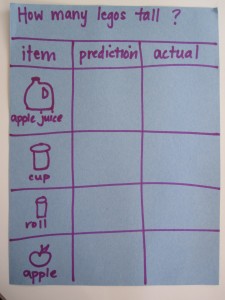How Many Legos Tall?
In this lesson, children will use a nonstandard unit of measurement such as LEGO blocks to measure objects in their environment.
Lesson for:
Toddlers/Preschoolers
(See Step 5: Adapt lesson for toddlers or preschoolers.)
Content Area:
Data Analysis and Probability
Measurement
Learning Goals:
This lesson will help toddlers and preschoolers meet the following educational standards:
- Formulate questions that can be addressed with data and collect, organize and display relevant data to answer these questions
- Develop and evaluate inferences and predictions that are based on data
- Understand measurable attributes of objects and the units, systems and processes of measurement
- Apply appropriate techniques, tools and formulas to determine measurement
Learning Targets:
After this lesson, toddlers and preschoolers should be more proficient at:
- Recognizing the attributes of length, volume, weight, area and time
- Understanding how to measure using nonstandard and standard units
- Selecting an appropriate unit and tool for the attribute being measured
- Measuring with multiple copies of units of the same size, such as paper clips laid end to end
- Using tools to measure
- Posing questions and gathering data about themselves and their surroundings
- Representing data using concrete objects, pictures and graphs
- Discussing events related to the children’s experiences as likely or unlikely

How Many Legos Tall?
Lesson plan for toddlers/preschoolers
Step 1: Gather materials.
- LEGOS (either LEGO Duplos or regular LEGOS)
- Markers
- Items to measure
- Sheet of paper (Make a chart with three columns: a column for the items to be measured, a column for predictions and a column for actual measurements. Draw the items for children who cannot yet read independently, but also write the item name with the drawing.)

- Chart paper to record the results of the group’s findings
Note: Small parts pose a choking hazard and are not appropriate for children age five or under. Be sure to choose lesson materials that meet safety requirements.
Step 2: Introduce activity.
- Ask if the children have ever played with LEGO blocks. “What did you do with the LEGO Blocks?” (Built various objects.) Explain that, today, the children are going to use LEGO blocks to measure items around the room.
- Model how the children are going to go about measuring the items on their list. Begin with an item that is not on their list, such as a stool. Ask the children to predict how many LEGOS high they think the stool is. Write their prediction under that column. Using the LEGOS and a volunteer, measure how many LEGOS tall the stool actually is by stacking the LEGOS one on top of another. Write the answer under the actual measurements column.
- Ask the children what they noticed about how many LEGOS tall they thought the chair would be and how many LEGOS tall the chair actually was. Was it more or less than they had predicted?
Step 3: Engage children in lesson activities.
- Explain to the children that now they are going to measure the items on their list. But, before they actually measure, the children will need to guess/predict how many LEGOS tall they think each item will be. Predict first, then measure.
- It is handy to have clipboards on hand for this activity, as it makes it easier for the children to write down their results.
- Once the children are done measuring, gather them together to discuss and record their results. The predictions will vary, but the actual measurement should be fairly consistent. If actual answers are wildly different, then measure the items again as a group.
- Discuss the difference between a prediction, a guess and an actual measurement.
Additional Extensions
- Ask the children to measure both the length and the width of each item. On the recording sheet, make four columns: a column for the predicted width of an item, a column for the actual width of an item, a column for the predicted length of the same item and a column for the actual length of the item.
- Ask the children to figure out the difference between their estimated number of LEGOS and the actual number of LEGOS. Say: “You estimated that the apple was 13 LEGOS tall. After you measured the apple, you found out that the apple was actually only five LEGOS tall. Ask: How many more LEGOS tall did you think the apple was? The difference between your prediction and the actual height is how many LEGOS?”
Step 4: Vocabulary.
- Predict: To guess what will happen next (e.g., Ask the children to predict how many LEGOS high they think the chair is.)
- Measure: Use of standard units to find out size or quantity in regard to: length, breadth, height, area, mass, weight, volume, capacity, temperature and time
- Difference: The distance between two numbers (e.g.,”The difference between your prediction and the actual height is how many LEGOS?”)
- How many: The total or sum (e.g.,”The difference between your prediction and the actual height is how many LEGOS?”)
Step 5: Adapt lesson for toddlers or preschoolers.
Adapt Lesson for Toddlers
Toddlers may:
- Have difficulty making predictions
- Have difficulty manipulating small LEGOS
Child care providers may:
- Skip the predicting column and go straight to the actual measurement
- Help the children snap the LEGOS together. Help align the snapped LEGOS with the measured item.
- Use the bigger LEGOS (called Duplo LEGOS) and ask the children to measure bigger items such as chairs or their own bodies
Adapt Lesson for Preschoolers
Preschoolers may:
- Have already grasped measuring with nonstandard units
- Have a strong number sense
Child care providers may:
- Have the children measure both the length and the width of each item. On the recording sheet, make four columns: a column for the predicted width of an item, a column for the actual width of the item, a column for the predicted length of the same item and a column for the actual length of the item.
- Have the children find the difference between what they estimated and the actual number of LEGOS. “You estimated that the apple was 13 LEGOS tall. After you measured the apple, you found out that the apple was actually only five LEGOS tall. How many more LEGOS tall did you think the apple was? The difference between your prediction and the actual height is how many LEGOS?”
Suggested Books
- How Big Is A Foot by Rolf Myller (New York: Yearling, 1991)
- How Tall, How Short, How Far Away? by David A. Adler (New York: Holiday House, 2000)
- Length by Henry Arthur Pluckrose (New York: Children’s Press, 1995)
Music and Movement
Outdoor Connections
- “Mother May I?” is a fun game to play outside. Review the different steps and notice that baby steps are small and jumps are bigger.
- Using any tool of nonstandard measurement (bigger playground blocks, children’s hands or feet), measure items outside. Measure “How many” hands long the slide is or “How many” shovels long the sandbox is or “How many” blocks long the playground is.

Comment on this lesson